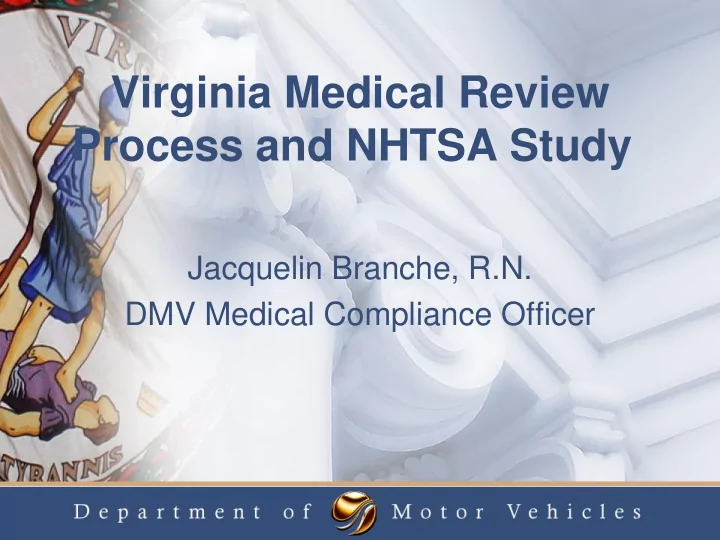

Virginia Medical Review Process and NHTSA Study Jacquelin Branche, R.N. DMV Medical Compliance Officer
Medical Review Assessments • To ensure motorist’s safety, drivers must meet certain requirements including vision, medical and mental standards • Overall medical review requirements are based on the Code of Virginia, as well as, guidance from DMV’s Medical Advisory Board
Code of Virginia • These standards are set by The Code of Virginia; specifically Va. Code Sections: • § 46.2-204 – Medical Advisory Board • § 46.2-322 – Review of Drivers • § 54.1-2966.1 – Reporting in good faith
Guiding Principles • Allow customers to drive as long as they can do so safely • Base driving on function, not age • Evaluate each case on its own merits
Reports of Impaired Drivers DMV receives reports from: • Law enforcement • Physicians • Courts • DMV representatives • Relatives • Concerned citizens • Self- disclosure (driver’s license application)
Reports of Impaired Drivers Reports must include: • Driver’s identifying information • Reason why reporting person is concerned • Relationship to the driver • Signature of person making the report • Contact information for the reporting person • Reports received by mail or fax
Medical Review Process Upon receipt of Medical Review request, DMV: Step 1: Reviews report Step 2: Follows up, if necessary Step 3: Determines medical review requirements to be imposed
Medical Review Process Requirements may include: • Medical report • Vision report • Knowledge test • Road test • Driver evaluation (outside of DMV)
Medical Review Process Step 4: Notify driver of requirements • Customer has 30 days to comply with initial medical/vision requirements • An additional 15 days is allowed to complete DMV testing or driver evaluation
Medical Review Process Step 5 : Evaluate all information Step 6 : Determine if additional information or tests are needed Step 7 : Review case with Medical Advisory Board, if necessary
Medical Review Process Step 8 : Determine next action(s) • End medical review (no further requirements/action needed) • Impose appropriate driver’s license restriction(s) • Require periodic medical/vision reports • Send driver to a driver rehab specialist • Suspend driving privilege
2007 NHTSA Study Purpose/Scope To develop an intervention to increase law enforcement medical review referrals • Reviewed the medical review process outcomes of: – 100 drivers referred by law enforcement – 105 drivers referred by 7 other sources
Data Collection Methods TransAnalytics selected 100 medical review cases referred by law enforcement (local and State Police) • Sorted list chronologically by license number within the specified date range • Selected every 11 th driver from each list • Yielded a stratified random sample
Data Collection Methods • Randomly collected data referred by 7 other sources (15 cases each), yielding sample of 105 drivers – Court incapacitated orders – General District Traffic Court – Customers themselves – DMV Representatives – Department for Blind & Vision Impaired – Family members & physicians –
Sample (Law Enforcement Referrals) • Referred drivers ages: 17 – 94 – 49% Male – 51% Female • Highest percent of referred ages: – 70 to 79 (23% of the sample) • 6% of state population is 70-79 – 80+ (24% of the sample) • 3% of state population is 80+ • 100 driver sample reduced to 72 drivers – 28 drivers eliminated for non-compliance
Sample (Law Enforcement Referrals) • Of the 72-driver sample: – 21 drivers furnished unacceptable medical or vision reports – 7 drivers (age 65 to 89) were referred to driver rehab by their MDs (6 of the 7 drivers did not comply)
Sample (Law Enforcement Referrals) Also, of the 72 drivers: • Another 4 furnished reports but were suspended due to failure to submit to other requirements (testing or rehab) • Another 21 were suspended, medically unfit to operate a motor vehicle
Sample (Law Enforcement Referrals) • Of 47 remaining, 35 received restrictions or remained on periodic review • 12 reviewed but resulted in no action (considered “non - quality” referrals)
Study Outcomes Law Enforcement Referrals 88% of LE referrals examined resulted in license actions • LE is an effective source of referrals • LE is an active source of referrals (35%) • Recommended that NHTSA continue to promote education & training programs to assist LE in identifying at-risk drivers and procedures for reporting
Study Outcomes (Referrals from Other Sources) • Only 8 drivers of total sample of 105 (8%) deemed fit to drive without restriction or continuing medical review • 87% of drivers referred by family members had license suspended • 73% of drivers referred by physicians had license suspended • 80% of drivers referred by prosecutors and judges had license suspended
Findings Those who refer medically at-risk drivers to VA DMV provide a valuable public safety service – Majority were quality referrals – Non-quality referrals may serve as data for the future if those drivers are involved in crashes or are referred again – Other-referred driver sample yielded a quality referral rate of 92% compared to 88% referred by law enforcement
Outreach and Education VADMV representatives provide outreach to: • Adult children of medically at-risk drivers • Physicians • Prosecutors and judges • Nursing homes/assisted living facilities • Colleges and universities • Schools • Medical support groups
Outreach and Education Public awareness tools resulting from Study: – Card - Red Flags of Medically At-Risk Drivers – DVD - Identifying the Medically At-Risk Driver • Additional initiative: Mature Driver Study
Law Enforcement Training on Referrals • NHTSA ongoing project underway for LE training, including training on referrals • Identifying the “At - Risk Driver” video – http://www.smartsafeandsober.org/resources/ videos.php
Reference U. S. DOT/NHTSA (2011). Medical review process and license disposition of drivers referred by law enforcement and other sources in Virginia. DOT HS 811 484.
Recommend
More recommend